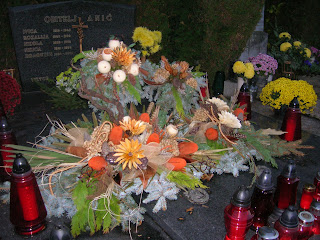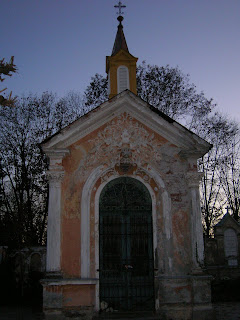Here are some pictures from the day and some information about the Cemetery.
Since this sign was made the cemetery has grown quite a bit. The brown patch of land on the left hand side of the picture is now half filled with graves. The graveyard is constantly expanding.


The cemetery was beautifully laid out and it was nice to walk throughout on such a wonderful autumn day. The flower arrangements from All Saints Day were still upon the graves so it added to the grandeur of the garden-cemetery.


 The cemetery reminded me of a maze with its high hedges and winding paths.
The cemetery reminded me of a maze with its high hedges and winding paths. On the right are empty graves. This cemetery is very beautiful it is a desirable place to be buried. Many people and families grave shop to secure a good location.
On the right are empty graves. This cemetery is very beautiful it is a desirable place to be buried. Many people and families grave shop to secure a good location. Costs of burial vary more depending on the location of the spot in the cemetery. The older the part of the cemetery the more expensive it becomes.
Costs of burial vary more depending on the location of the spot in the cemetery. The older the part of the cemetery the more expensive it becomes. The company Parkovi maintains the city cemetery. Allot of work goes into keeping it in such a pristine state. Their goal is to "preserve the horticultural idea of the creator of the cemetery Herman Haller." People pay a sort of tax for the maintenance of the cemetery. It takes allot of time and manpower to maintain the cemetery as there are numerous plants over an extensive area. They do a wonderful job maintaining it.
The company Parkovi maintains the city cemetery. Allot of work goes into keeping it in such a pristine state. Their goal is to "preserve the horticultural idea of the creator of the cemetery Herman Haller." People pay a sort of tax for the maintenance of the cemetery. It takes allot of time and manpower to maintain the cemetery as there are numerous plants over an extensive area. They do a wonderful job maintaining it.
 In the past there was a large problem with people breaking into the cemetery after hours (the gates are closed at 9:00) and stealing flower arrangements to take home. Nowadays there are video cameras throughout the park to prevent this from happening.
In the past there was a large problem with people breaking into the cemetery after hours (the gates are closed at 9:00) and stealing flower arrangements to take home. Nowadays there are video cameras throughout the park to prevent this from happening.

 In many places the hedges have grown out and around the headstones. The maintenance workers carefully trim around them, making the graves apart of the garden.
In many places the hedges have grown out and around the headstones. The maintenance workers carefully trim around them, making the graves apart of the garden.
 Sun set in the graveyard. It was only 5:00.
Sun set in the graveyard. It was only 5:00.

 The cross and candles located on the cemetery's main pathway.
The cross and candles located on the cemetery's main pathway.
 A very elaborate and expensive grave located on the outer wall. This is located in one of the older sections of the graveyard.
A very elaborate and expensive grave located on the outer wall. This is located in one of the older sections of the graveyard. There are many older graves that are no longer visited, like this one. After a certain period of time where no upkeep is done, Parkovi replaces the headstone but leaves the original grave untouched. It is very expensive to do this.
There are many older graves that are no longer visited, like this one. After a certain period of time where no upkeep is done, Parkovi replaces the headstone but leaves the original grave untouched. It is very expensive to do this.
 The World War I memorial. During the war soldiers were buried where they died but afterwards it was recognized that a decent memorial was needed. Haller's idea resulted in the planting of arborvitae in a form of a large rectangle with four entrances. In the centre of the walk intersection, a single lime tree to represent the Slav people and three worlds: "underground, earthly and heavenly." The personal numbers of those soldiers who lost their lives were engraved on small tiles and placed on the grass. Unfortunately, since then the grass has covered them.
The World War I memorial. During the war soldiers were buried where they died but afterwards it was recognized that a decent memorial was needed. Haller's idea resulted in the planting of arborvitae in a form of a large rectangle with four entrances. In the centre of the walk intersection, a single lime tree to represent the Slav people and three worlds: "underground, earthly and heavenly." The personal numbers of those soldiers who lost their lives were engraved on small tiles and placed on the grass. Unfortunately, since then the grass has covered them.
 The Oršić family Chapel.
The Oršić family Chapel. Graves along the outer wall. The graves are old but have been updated by the families to keep the appearance up. Several generations are buried within the graves. The older the graves the more names upon them. The deceased are buried one on top of another.
Graves along the outer wall. The graves are old but have been updated by the families to keep the appearance up. Several generations are buried within the graves. The older the graves the more names upon them. The deceased are buried one on top of another. This grave is where the priests are buried. As you can see there are allot that lie here. There is a newer grave set aside for priests once this is full.
This grave is where the priests are buried. As you can see there are allot that lie here. There is a newer grave set aside for priests once this is full.
 After the burial this is what the graves typically look like. Wreaths are laid on a stand like this after the burial ceremony.
After the burial this is what the graves typically look like. Wreaths are laid on a stand like this after the burial ceremony.










 No one knows who is buried in this grave.
No one knows who is buried in this grave.





1 comment:
Bonjour, j'ai vu une photo d'une pierre tombale au cimetière de Varazdin sur votre blog de
Georges THINAULT et de sa famille .Il se trouve que ces personne sont de ma famille .En fait je recherche de la famille de Marianne VRACUN. Je vous remercie par avance de l'aide que vous voudriez m'apporter . Salutations. Joseph THINAULT. adresse email :jthinault@wanadoo.fr
Post a Comment